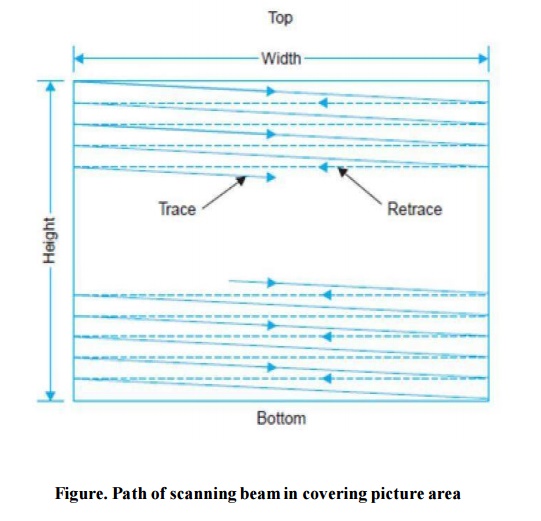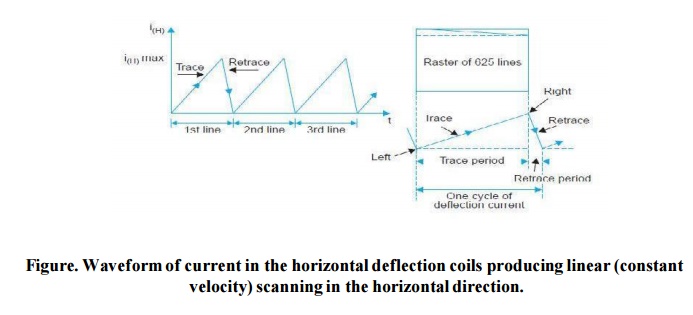Chapter: Television and Video Engineering : Fundamentals of Television
Image Continuity
IMAGE CONTINUITY
While
televising picture elements of the frame by means of the scanning process, it
is necessary to present the picture to the eye in such a way that an illusion
of continuity is created and any motion in the scene appears on the picture
tube screen as a smooth and continuous change.
To
achieve this, advantage is taken of ‘persistence of vision’ or storage
characteristics of the human eye. This arises from the fact that the sensation
produced when nerves of the eye’s retina are stimulated by incident light does
not cease immediately after the light is removed but persists for about 1/16th
of a second.
Thus if
the scanning rate per second is made greater than sixteen, or the number of
pictures shown per second is more than sixteen, the eye is able to integrate
the changing levels of brightness in the scene. So when the picture elements
are scanned rapidly enough, they appear to the eye as a complete picture unit,
with none of the individual elements visible separately.
In
present day motion pictures twenty-four still pictures of the scene are taken
per second and later projected on the screen at the same rate. Each picture or frame
is projected individually as a still picture, but they are shown one after the
other in rapid succession to produce the illusion of continuous motion of the
scene being shown.
A shutter
in the projector rotates in front of the light source and allows the film to be
projected on the screen when the film frame is still, but blanks out any light
from the screen during the time when the next film frame is being moved into
position.
As a
result, a rapid succession of still-film frames is seen on the screen. With all
light removed during the change from one frame to the next, the eye sees a
rapid sequence of still pictures that provides the illusion of continuous
motion. Scanning. A similar process is carried out in the television system.

The scene
is scanned rapidly both in the horizontal and vertical directions
simultaneously to provide sufficient number of complete pictures or frames per
second to give the illusion of continuous motion. Instead of the 24 as in
commercial motion picture practice, the frame repetition rate is 25 per second
in most television systems.
Horizontal
scanning. Fig. (a) shows the trace and retrace of several horizontal lines. The
linear rise of current in the horizontal deflection coils (Fig. (b)) deflects
the beam across the screen with a continuous, uniform motion for the trace from
left to right.
At the
peak of the rise, the sawtooth wave reverses direction and decreases rapidly to
its initial value.
This fast
reversal produces the retrace or flyback. The start of the horizontal trace is
at the left edge of raster. The finish is at the right edge, where the fl yback
produces retrace back to the left edge. Note, that ‘up’ on the sawtooth wave
corresponds to horizontal deflection to the right. The heavy lines in Fig. (a)
indicate the useful scanning time and the dashed lines correspond to the
retrace time.
Vertical
scanning. The sawtooth current in the vertical deflection coils (see Fig.)
moves the electron beam from top to bottom of the raster at a uniform speed while
the electron beam is being deflected horizontally.
Thus the
beam produces complete horizontal lines one below the other while moving from
top to bottom. As shown in Fig. (c), the trace part of the sawtooth wave for
vertical scanning deflects the beam to the bottom of the raster. Then the rapid
vertical retrace returns the beam to the top.
Note that
the maximum amplitude of the vertical sweep current brings the beam to the
bottom of the raster. As shown in Fig. (b) during vertical retrace the horizontal
scanning continues and several lines get scanned during this period. Because of
motion in the scene being televised, the information or brightness at the top
of the target plate or picture tube screen normally changes by the time the
beam returns to the top to recommence the whole process.
This
information is picked up during the next scanning cycle and the whole process
is repeated 25 times to cause an illusion of continuity. The actual scanning
sequence is however a little more complex than that just described and is
explained in a later section of this chapter. It must however be noted, that
both during horizontal retrace and vertical retrace intervals the scanning
beams at the camera tube and picture tube are blanked and no picture
information is either picked up or reproduced.
Instead,
on a time division basis, these short retrace intervals are utilized for
transmitting distinct narrow pulses to keep the sweep oscillators of the
picture tube deflection circuits of the receiver in synchronism with those of
the camera at the transmitter.
This
ensures exact correspondence in scanning at the two ends and results in
distortion less reproduction of the picture details.

Related Topics